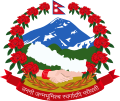| This article is part of a series on the |
| Culture of Nepal |
|---|
 |
| Society |
| Arts and literature |
| Other |
| Symbols |
|
|
Nepalese Painting or Nepali Painting begins with the religious paintings with Hindu and Buddhist subjects, almost all Newa art by the Newari people of the Kathmandu valley. These traditional paintings can be found in the form of either wall paintings, cloth paintings called paubha, or manuscripts. They used conservative technique, style, and iconography in their works for centuries.[1]
Nepalese paintings believed to have embraced western influences after 1850 with a work of Bhajuman [Chitrakar], a traditional artist who became acquainted with western Realism after visiting Europe. Bhajuman, also known as Bhajumacha Chitrakar, was a court painter of Jung Bahadur Rana, who visited Europe in 1850 after becoming Prime Minister of Nepal. As a member of the new Prime Minister's entourage, Bhajuman also visited Paris and London. Soon after the return, western Realism supposedly influenced Bhajuman's paintings, marking the start of modern trend. An unsigned painting - supposedly to have painted by Bhajuman - depicts a Thapa General in a full military regalia.[2] This painting remained a pivotal example of considerable departure from an established traditional school of Nepali painting to the western school of art practice. However, the recent discovery of the illustrations by Raj Man Singh Chitrakar (1797-1865) for his patron a British Resident Brian Houghton Hodgson, sheds light on the western Realism entering Nepal way before the influences brought in by Bhajuman Chitrakar.S[3] to Nepalese people
- ^ Brown, Kathryn Selig. "Nepalese Painting". The Metropolitan Museum of Art. Retrieved 19 November 2017.
- ^ Tej Bahadur Chitrakar icon of transition by Madan Chitrakar 2004
- ^ "Library and Archives | Natural History Museum". www.nhm.ac.uk.



